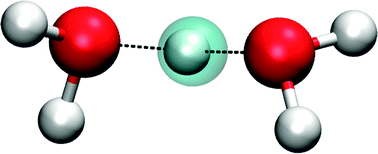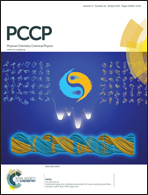Tuning the reactivity of a dissociative force field: proton transfer properties of aqueous H3O+ and their dependence on the three-body interaction†
Abstract
The proton transfer properties of the dissociative water potential developed by Garofalini et al. were closely examined by carefully analyzing the pairwise screening functions of the three-body interaction. It was shown that a simultaneous adjustment of the exponential screening factor and the three-body cutoff distance enables a selective adjustment of the diffusive properties of an excess proton, while at the same time structural and other dynamical data remain unaffected to a large extend. To investigate proton transfer properties without the influence of nuclear quantum effects, deuterated systems have been investigated in addition to their hydrogen counterparts. It was shown that the suggested parameter set A leads to significantly improved diffusion coefficients and proton hopping rates. Comparison of proton transfer correlation functions to simulation data obtained from Car–Parrinello molecular dynamics simulations confirms the improved performance of the adjusted parametrization.


 Please wait while we load your content...
Please wait while we load your content...